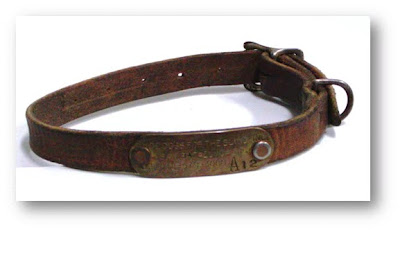
This year, as we celebrate our 70th Anniversary, it's good to hear from people who are connected with our history. Franzi Corman came across a leather collar that brought back a flood of memories. She writes about Clarence Pfaffenberger, who began establishing standards for Guide Dog breeds at GDB in the 40s. Pfaffenberger volunteered at GDB for 21 years and is credited with developing the puppy raising and breeding programs.
by Franzi Corman
I grew up in the 1940’s and was an extremely shy child who really found it hard to talk to anyone. My name was Francie Bauer at that time, and I had begged for a dog since I was 5 years old. When I was 11 my father said those magic words to me, ”You can have a dog.”
He bought me a German shepherd puppy and signed me up for twice-weekly training classes at the Continuation School in San Francisco. There were three trainers and Clarence Pfaffenberger was one of them. I adored him because he always jumped around and happily cheered his dogs on and taught us to do the same. It was my first encounter with positive reward training. I actually did very well with my dogs in all my classes, and found some sense of myself in that dog training environment.
Sadly, my puppy died from Distemper at around 8 months, which was not uncommon at that time with no vaccinations or easy cure available. I was heartbroken and there was no money for another puppy.
I knew of “Pfaff’s” connection to Guide Dogs for the Blind and had been enchanted by the idea of Guide Dogs ever since I could read. I wouldn't have had the courage to ask Pfaffenberger about getting a Guide Dog puppy and can’t remember the details of how it came about, but it was Pfaff who knew me, trusted me and wanted to help me have dogs.
That is how my life with GDB’s German Shepherd “Dolly” #A12 began in 1949. Dolly was solid black and very large-boned for a female. I loved her, thought she was beautiful, and worked hard on her training with dreams of seeing her someday wearing that special harness and helping a person who was blind. Unfortunately, that did not happen. Dolly was quite shy and I did not understand the seriousness of her shyness until she was dropped from formal training. As much as I loved her and felt joy at having her back, it was a huge disappointment to me that she was not able to be a Guide Dog, however, raising Dolly was a significant event in my life.
I continued to train and love dogs, and many years later, when my children were old enough to get into 4H,I signed up to be a Guide Dog Project leader in Palo Alto from the late 1960s to early 1970s. Golden Retriever “Banner” (from the book Banner Forward) was a puppy raised by one of the girls in my Guide Dog puppy group. So after many years, my dream to see my Guide Dog puppy graduate did come true in another form after all.
Keeping Dolly’s collar for all these years has seemed natural. Meeting [GDB's Director of Research and Development] Michele Pouliot a few years ago was poignant to say the least, as it made me feel as though I had returned to the organization that started my life with dogs. It feels right to give Dolly’s collar back to GDB for a place of historical honor. I’m very happy that the collar I have cherished for so long is now back where it started.
Thanks so much to GDB!
No comments:
Post a Comment